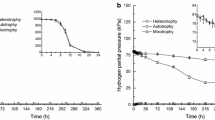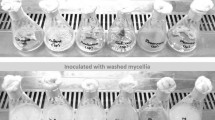Abstract
The Aspergillus niger strain BO-1 was grown in batch, continuous (chemostat) and fed-batch cultivations in order to study the production of the extracellular enzyme glucoamylase under different growth conditions. In the pH range 2.5–6.0, the specific glucoamylase productivity and the specific growth rate of the fungus were independent of pH when grown in batch cultivations. The specific glucoamylase producivity increased linearly with the specific growth rate in the range 0–0.1 h−1 and was constant in the range 0.1–0.2 h−1. Maltose and maltodextrin were non-inducing carbon sources compared to glucose, and the maximum specific growth rate was 0.19 ± 0.02 h−1 irrespective of whether glucose or maltose was the carbon source. In fed-batch cultivations, glucoamylase titres of up to 6.5 g l−1 were obtained even though the strain contained only one copy of the glaA gene.
Similar content being viewed by others
Author information
Authors and Affiliations
Additional information
Received: 5 May 1999 / Received revision: 7 September 1999 / Accepted: 17 September 1999
Rights and permissions
About this article
Cite this article
Pedersen, H., Beyer, M. & Nielsen, J. Glucoamylase production in batch, chemostat and fed-batch cultivations by an industrial strain of Aspergillus niger . Appl Microbiol Biotechnol 53, 272–277 (2000). https://doi.org/10.1007/s002530050020
Issue Date:
DOI: https://doi.org/10.1007/s002530050020




